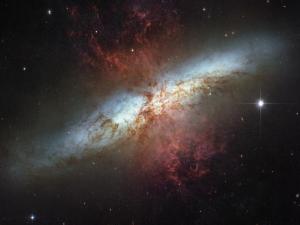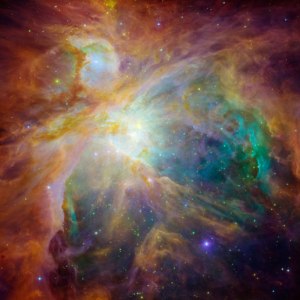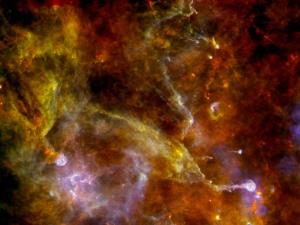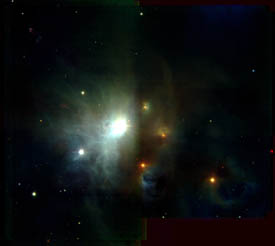Stars begin life as clouds of cold gas and dust that transform into blazing hot fireballs

Star dust, star dust, burning bright
Amid the glare of ancient light
Eternity stares back from the past
Reborn we’ll be one day at last
NASA astronomy: stellar astrophysics
Astronomy questions and answers – September 19, 2013 – Walk out to a dark viewing spot anywhere on the Earth on a clear night and look up at the night sky. Your eyes will take in ancient light from stars in the Milky Way that covers the whole sky above you. Deep within the stellar nurseries of the Milky Way new stars are being formed using processes NASA astronomers are currently studying in an attempt to understand how stars are born. Star forming processes responsible for the formation of the stars you see in the night sky. Processes they can see at work in the stellar nurseries of the Milky Way, like the Orion Nebula (M42) and Cygnus X.

Journey with me to stellar nurseries deep within the dark regions of the Milky Way, the dark patches you can see in the night sky above. The birthing grounds of young stars in the Milky Way, these dark patches in the night sky are in fact clouds of interstellar gas that appear dark because they block the starlight from distant stars. Astronomers believe deep within the birthing grounds of the Milky Way, new stars are being formed at the rate of about 2 or 3 new stars each year.

Star formation theories
Present theories on star formation put forth by NASA astronomers show star formation is a complicated process affected by nearby massive stars, other star forming regions, and even the spiral structure of the Milky Way. These theories only become more complicated when astronomers look at the formation of groups of stars.
In order to try to simulate star formation, some astronomers use sophisticated computer models, while others incorporate observations in different wavelengths and use them to create three-dimensional images of the sky. Working together these two different groups of astronomers are trying to determine exactly how stars are born.
NASA astronomers working on present theories of star formation think the Milky Way is filled with clouds of gas and dust they call the interstellar medium. They also think slight over densities within these clouds of gas and dust could trigger star formation, over densities that could be produced by the turbulent forces present in these clouds of gas and dust. Astronomers studying slight over densities within star forming clouds of gas and dust believe these slightly denser regions could eventually become main sequence stars within a few million years.
Some NASA astronomers believe the intense radiation from groups of hot, bright stars located close to one another could create the necessary turbulence in the interstellar medium to trigger star formation. Other astronomers believe nearby galaxies and even large clouds of gas and dust could cause turbulence in the interstellar medium which could also be part of the star forming process. Many astronomers also believe the resulting shock wave after a supernova could create spiral density waves capable of compressing material and initiating star formation.
Gravity at Work
Present theories on the formation of main sequence stars being proposed by NASA astronomers involves the force of gravity. Gravity pulls the gas and dust within the interstellar medium into denser regions, which results in a cloud increasing in size and contracting. The rotation velocity of the cloud increases as it contracts due to conservation of angular momentum, in the same way a figure skater’s spin speed increases as they bring their arms closer to their body.
At the same time the temperature in the core of the cloud increases as it shrinks due to the force of gravity. The charged particles within the cloud at this time can only move in specific directions in the magnetic field in the region. This results in the rotational velocity of the cloud slowing, but not stopping, otherwise astronomers think stars would never form in these dense clouds of gas and dust.
In the case of main sequence stars astronomers think regions of dense clouds of gas and dust would begin to contract to an area the size of our solar system tens of thousands of years after beginning to slow. At this time astronomers think the temperature at the centre of dense clouds of dust and gas would be in the region of 10,000 kelvins. They call the central region of such a cloud at this time a protostar.
Protostars

Protostars at this time in their life cycle are often more luminous than the main sequence star they eventually become, because they have a greater surface from which to radiate energy. This brightness allows NASA astronomers to view protostars as they continue to gravitationally attract more gas and dust, shrink and heat up internally. The luminosity of a protostar begins to decrease as it’s outer surface shrinks under the force of gravity. Astronomers believe the cloud and protostar eventually spin faster and flatten out into a disk.
Astronomers using data collected by several different astronomical instruments recently presented far-infrared images of three Class 0 protostar systems in Perseus: L1448C, the triple system L1448N, and IRAS 03282+3035. Seven hundred and fifty light-years from Earth, all three of these protostars were seen powering bipolar molecular outflows, which astronomers think are in fact epic jets of water being thrust into interstellar space. Calculations by NASA astronomers indicates these jets of water are shooting out into interstellar space at speeds of around 120,000 miles per hour and at a rate equal to about 100 million times the volume of water flowing in the Amazon every second of the day.
Astronomers think these jets of water and material help to channel radiation and mass away from the protostar, which helps to clear the central region of debris and reveal the protostar. They also think it could be possible the galaxy was seeded with water through this process, which might change thoughts on the possibility of life in the galaxy. The remaining material is then accreted by the protostar, or forms part of a residual disk, which NASA astronomers think could form planets.
The core of a protostar will reach 1 million kelvin at sometime during the contraction and heating up of the cloud, at which time it will begin fusing deuterium to helium. Deuterium is the easiest nucleus to fuse, so it makes sense this would be the starting point. Once the core has contracted enough to reach a density where the core reaches 10 million degrees kelvins, hydrogen nuclei will begin fusing into helium. At this point star astronomers also think a protostar will reach an equilibrium point where the radiative energy from fusion balances gravitational pull of its mass. This new star is now a main sequence star, which has formed over millions of years.
Simulating the Birth of a Star
The process of star birth takes millions of years to complete, so how do astronomers determine the way outside factors affect the process by which new stars are born? Modern astronomers are presently using supercomputers to help simulate star formation models in the hope they can determine why the mass distribution of newly formed stars appears to be universal. They want to understand why this average mass of newly formed stars exists. They also want to know the process by which it occurs.
Present star formation models take into account the effects of thermodynamics, magnetic fields, radiative processes, and of course gravity. Star astronomers are also trying to determine other factors they need to include in models, like the way new stars affect their own star forming environments. This includes factors like young stars heating up the gas and dust surrounding them and moving gas and dust around through bipolar molecular flows.
The key question NASA astronomers want to answer at this point is whether or not present star formation models can reproduce the properties of exact parts of the star forming process. Astronomers will also want to determine the most massive star that can be formed depending on the size of a cloud of dust and gas. They’ll try to find answers by looking at the chemical composition, magnetic fields, ionization, age and other factors of large clouds of star forming dust and gas in the night sky.
Peering into Stellar Nurseries
How do NASA astronomers look into the heart of stellar nurseries in the Milky Way? Astronomers use instruments designed to detect specific wavelengths of light radiation emitted during the formation of new stars. During the beginning stages of star birth a new star emits radio waves as it contracts astronomers look for as an indicator of new star formation. At this time the core of a contracting cloud of gas and dust is too cold to emit visible and infrared radiation.
Once the cloud forms a protostar it will begin to emit light radiation, which will be blocked by the material surrounding the new star. The light radiation emitted by a protostar is absorbed by the surrounding material, which radiates infrared radiation toward Earth NASA astronomers detect using space and ground-based telescopes specifically designed for the job.
Astronomers have used the Spitzer Space Telescope to view hundreds of protostars forming in large clouds of gas and dust in the stellar nurseries of the Milky Way. In the future they’ll use instruments and telescopes designed to detect millimetre waves in the microwave range in order to get a better view of the beginning stages of star birth. To date astronomers report detecting a compact source embedded in cold gas within stellar nurseries only detectable at these wavelengths.
NASA astronomers trying to piece together the puzzle of star formation in the Milky Way are also using reconstructed images of star-forming regions from past observations. Using 2-D images, positional data, and velocities for an entire cloud, they have been able to create 3-D models researchers can then analyze. 3-D models that show unforeseen structures hidden within stellar nurseries and even regions of star formation they weren’t expecting to see.
Click this link to watch a You Tube videos on how a star is born
Does the cosmos inspire your imagination. Check out this astronomy blog I have created and let me know what you think? http://astronomytonight.yolasite.com/.
Read about NASA’s Messenger spacecraft and its mission to Mercury
Have you heard about the recent meteorite that exploded near the Ural Mountains
